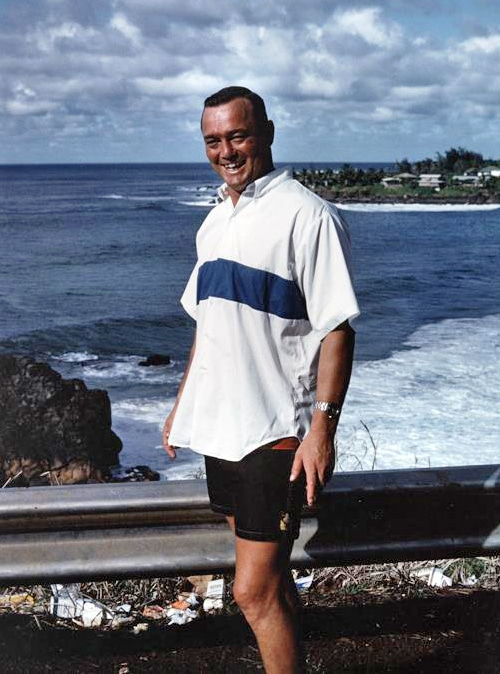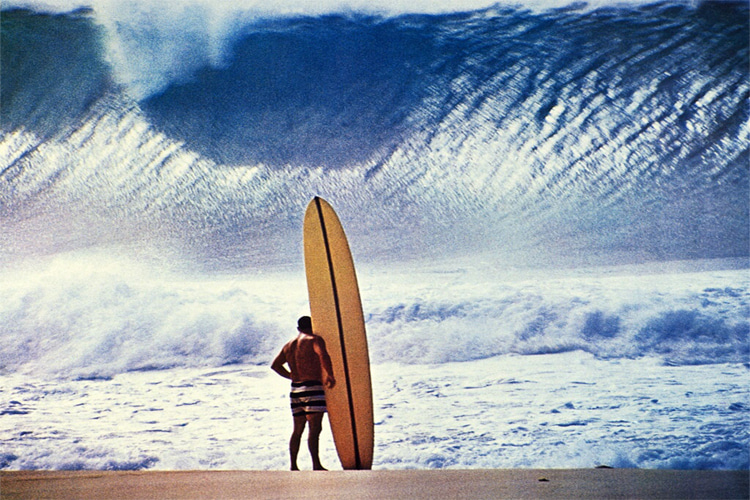Big wave surfing pioneer Greg Noll passed away of natural causes at the age of 84 in Crescent City, California.
He is widely regarded as the first person to ride Waimea Bay in 1957.
Greg Lawhead was born on February 11, 1937, in San Diego, California.
He moved to Manhattan Beach at the age of six with his just-divorced mother. His name changed after her mother married Ash Noll, a chemical engineer.
Greg started surfing at the age of 10 and quickly became one of the finest hotdoggers in the Los Angeles area.
By that time, he had learned to shape surfboards with Dale Velzy.
Noll was a member of the Los Angeles County Lifeguards and rode his first challenging waves in the Palos Verdes area, including Lunada Bay.
In 1954, he visited Hawaii for the first time, where he finished his senior year at Waipahu High School.
He got used to surf Makaha, and soon, he was exploring the North Shore of Oahu and its several legendary surf breaks.
His first trip to the Hawaiian islands changed the way he looked at waves - the bigger, the better.
On his next visits to Oahu, he started taking on the bigger waves of Sunset Beach.

Waimea Bay, November 7, 1957
But in 1957, Greg Noll was prepared for the ride of a lifetime.
Fourteen years after the death of Dickie Cross at Waimea Bay, Noll, and seven other surfers paddled out at the deepwater surf spot in firing 15-foot surf.
For decades, Waimea Bay was considered a no-surf zone even by local Hawaiian wave riders.
A new chapter had been opened at the infamous surf break, and Greg Noll was ready to embrace surfing for life.
He published books and shot movies, but it was Greg Noll Surfboards that made him a timeless icon.
By 1966, his business was the largest surfboard-shaping structure in the world, producing over 200 boards per week.
"Da Bull," as he was affectionately known, shaped the iconic Miki Dora signature boards.
At 6'2'', Noll kept riding Waimea throughout the 1960s, with some of his waves being included in several surf movies, including 1966's "The Endless Summer."
Equipped with his black and white stripe, jailhouse-style surf trunks, Greg remained, mostly, a free surfer.
Nevertheless, in 1966, he made the finals of the Duke Kahanamoku Invitational.
One Last Shot
Three years later, on December 4, 1969, the surfer giant dopped into a 35-foot mountain at Makaha, got to the bottom of the wave, and got pounded by a massive wall of water.
For 20 years, it remained as one of the largest waves ever ridden.
"Some of my best friends have said it was a death-wish wave. I didn't think so at the time, but in retrospect, I realize it was probably bordering on the edge," Noll wrote in his autobiography.
For him, that was it.
Greg Noll moved to Alaska for a while and then spent 20 years working as a commercial fisherman in Crescent City, California.
In the late 1980s and 1990s, Noll's historical feats were brought to life, and the larger-than-life character resurged in movies and TV documentaries.
The big wave surfer created a clothing company - Da Bull - and got back to the shaping room for a unique, limited-edition re-creation of his 1950s surfboards.
Greg Noll was inducted into the Huntington Beach Surfing Walk of Fame in 1966.
For more on Noll's personal life and career achievements, watch "Surf Crazy" (1959), "Gun Ho!" (1963), "Strictly Hot" (1964), "Ride the Wild Surf" (1964), "Golden Breed" (1968), "Surfers: The Movie" (1990), and "Riding Giants" (2004).
